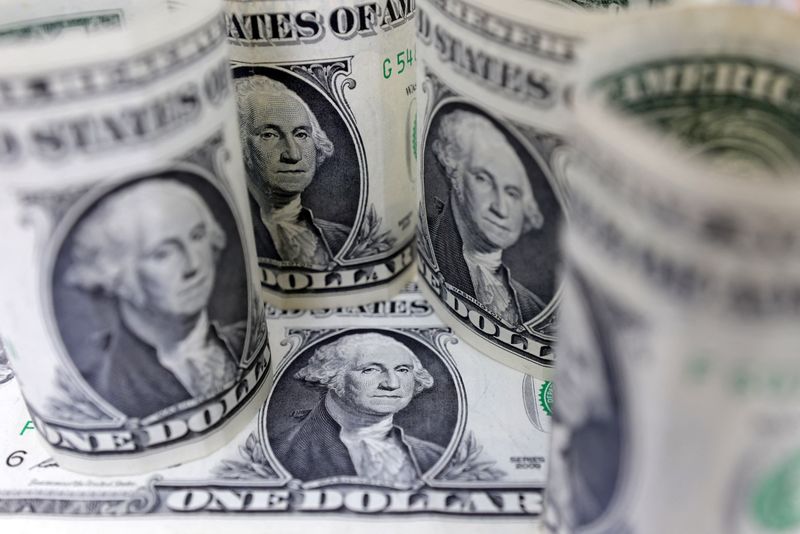Yen bears rush for the exits on hints of BOJ policy shift
2023.12.08 01:47

© Reuters. U.S. Dollar banknotes are seen in this illustration taken July 17, 2022. REUTERS/Dado Ruvic/Illustration/File Photo
By Rae Wee
SINGAPORE (Reuters) -The yen extended its sharp rally on Friday and marched toward its best week against the dollar in nearly five months, as traders ramped up expectations that the end of Japan’s ultra-low interest rates was nearing.
The broad strength in the yen kept a lid on the dollar, which also stayed on the defensive ahead of the closely-watched U.S. nonfarm payrolls report due later on Friday.
Bank of Japan (BOJ) Governor Kazuo Ueda said on Thursday the central bank had several options on which interest rates to target once it pulls short-term borrowing costs out of negative territory. Ueda had on the same day met with Prime Minister Fumio Kishida.
Markets took those comments as the clearest sign yet that the BOJ could soon phase out its ultra-loose monetary policy and catapulted the yen to multi-month highs against its major peers.
Against the dollar, the yen was last nearly 0.3% higher at 143.74, having surged more than 1% against the greenback earlier in the session.
The yen had gained over 2% on Thursday, its largest daily rise since January, and was likewise set to end the week with a more than 2% jump.
“Obviously, the markets got very excited,” said Ray Attrill, head of FX strategy at National Australia Bank (OTC:) (NAB).
The yen had, as recently as a month ago, fallen to a one-year low of 151.92 per dollar, coming under pressure as a result of growing interest rate differentials with the United States.
The weakening yen previously kept traders on edge over potential intervention from Japanese authorities to prop up the currency as it had done last year.
Sterling fell to a two-month low of 179.56 yen on Friday and against the euro, the Japanese currency last stood at 155.15, not too far from the previous session’s four-month peak of 153.215 per euro.
Attention now turns to the BOJ’s upcoming two-day monetary policy meeting on Dec. 18 for clues on whether the ultra-dovish central bank will indeed signal a policy shift.
“I think a lot of us have felt that we were going to have some sort of more meaningful policy change this year, and we’ve been disappointed. So I’m a bit reluctant to jump on the bandwagon and say that (a change) is going to happen on the 19th,” said NAB’s Attrill.
“But obviously, there’s no smoke without fire… So I guess the market is understandably taking the view that the December meeting is live now.”
Separately, revised data on Friday showed Japan’s economy shrank more sharply than first estimated in the third quarter.
ALL EYES ON PAYROLLS
In the broader market, the dollar largely drifted sideways, with currency moves outside of the yen subdued ahead of U.S. jobs data.
The euro steadied at $1.0783 and was eyeing a weekly decline of more than 0.9%, while sterling last bought $1.2595 and was similarly headed for a weekly fall of nearly 1%.
The was little changed at 103.67 and on track to gain more than 0.4% for the week. That would snap three straight weeks of declines, as the greenback attempts to stem losses from its heavy selloff in November.
“I’m more interested in seeing what happens with the unemployment rate and what happens with average earnings than the nonfarm payrolls numbers,” said NAB’s Attrill.
“Obviously, if we get a big shock on the payrolls – a big downside or upside surprise – the markets’ initial reaction will be governed by that.”
Elsewhere, the Australian dollar rose 0.17% to $0.6613.
In China, the yuan weakened against the dollar and was poised to snap a three-week winning streak.
Data on Thursday showed the country’s exports grew for the first time in six months in November, though imports unexpectedly shrunk.
Concerns over the country’s growth outlook continue to mount, with investor sentiment still fragile on the back of an uneven post-COVID recovery in the world’s second-largest economy.
Moody’s (NYSE:) had, earlier this week, slapped a downgrade warning on China’s credit rating, and followed up a day later with cuts to its outlook on Hong Kong, Macau and swathes of China’s state-owned firms and banks.
“Moody’s downgrade of China’s rating outlook was motivated by concern over China’s rising debt levels and possible need to bailout local state-owned enterprises,” said William Xin, fixed income portfolio manager at M&G Investments, though he said the move had “failed to consider” Chinese policymakers’ emphasis on reducing debt over the years.








